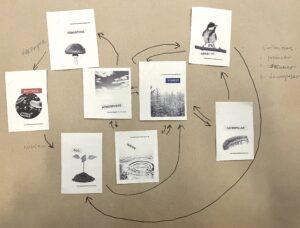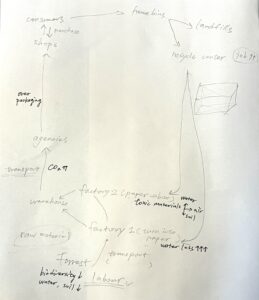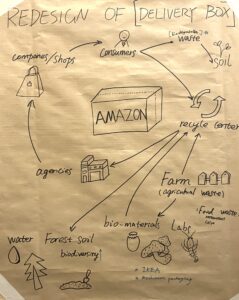WEEK5- Green Pulse
Designing for a Just and Sustainable World
My recent research and practice have been influenced by many of the insightful ideas presented in this week’s lectures, involving the global context of political ecology and environmental design. These stories are not just about struggles over resources and rights, they also show how design activism can reconfigure systems and redistribute resources to promote more equitable social structures.
I began to see design as a political act, one that went beyond simply creating colorful objects, and involved questioning and transforming existing social structures through material practice. I am learning to incorporate circular economy principles into my designs so that my work is not only aesthetic but also environmentally friendly. This requires paying more attention to materials, manufacturing processes and how products are disposed of at the end of their life cycle.
By reading Edward Burtynsky’s work and watching related documentaries, I have a deeper understanding of modern consumer culture and its impact on the environment. These works inspired me to think about how to tell different stories in design and how to challenge and change the traditional view of objects through design. Hornborg argues that we are trapped in a collective fantasy about the nature of modern technology that prevents us from imagining solutions to economic and environmental crises other than technocratic fixes (Alf Hornborg, 2001). He shows how the power of machines produces increasingly asymmetric exchanges and distributions of resources and risks between distant populations and ecosystems, leading to an increasingly polarized world order.
Linear vs Circula Workshop


Figure 1: Group Work of System Discussion, Sally Li, 2024
In this week’s workshop, we discussed the differences and similarities between linear systems and living systems. We found that although they both have producers, consumers, and decomposers within the system, the living system is completely circular and each part of it can contribute to the others. On the other hand, products from the linear system will end up in landfills and the life of it also causes plenty of pollution and waste. This comparison process gave me a new insight to rethink the process of design and the whole life of a design product at each stage.

Figure 2: The Regular System of Delivery Box, Sally li, 2024

Figure 3: Redesign of Delivery Box System, Sally li, 2024
We chose a delivery box as our product to redesign. Firstly, we discussed the regular production chain which contains a lot of harm to the environment like greenhouse gases and toxic substances produced by factory production and transportation (Figure 2). Although we already have recycled centers to deal with waste and sustainable bio-material companies like Ikea and mushroom packaging, it still costs huge amounts of labor. So we thought that we could create a more streamlined system that cut the process between producers, consumers and decomposers (Figure 3).
bibliography
Alf Hornborg (2001). The Power of the Machine. Rowman Altamira.
Figure 1,2,3 are my own work